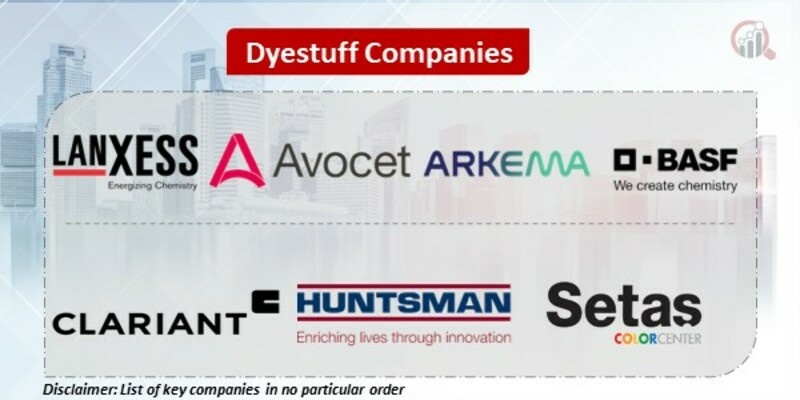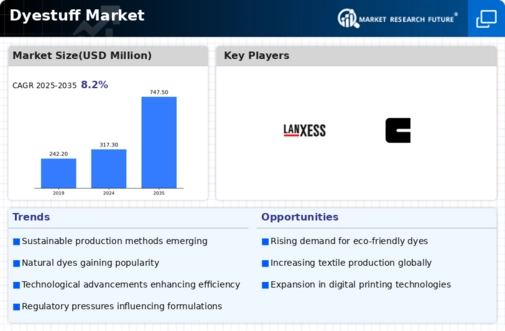Top Industry Leaders in the Dye Stuff Market
 In the vibrant world of textiles, dyes reign supreme, weaving magic with color and transforming ordinary fabrics into captivating canvases. the dyestuff arena hums with activity, where established giants jockey for position with nimble niche players, all vying to paint the market with their vibrant solutions.
In the vibrant world of textiles, dyes reign supreme, weaving magic with color and transforming ordinary fabrics into captivating canvases. the dyestuff arena hums with activity, where established giants jockey for position with nimble niche players, all vying to paint the market with their vibrant solutions.
The Color Champions and their Palette of Power:
-
Global Titans: Behemoths like Archroma (Switzerland), Huntsman Corporation (US), and BASF SE (Germany) wield immense power through their vast production capacities, diverse dye offerings (reactive, acid, direct), and established presence across various textile sectors. Archroma leads the pack with its commitment to sustainable and eco-friendly dyeing solutions. -
Regional Masters: Companies like Clariant AG (Switzerland) and Zhejiang Rongsheng Holding Group Co., Ltd. (China) excel in specific regions due to their localized expertise, regulatory knowledge, and strong relationships with regional textile manufacturers. Zhejiang Rongsheng caters to the booming Asian textile market with its cost-effective dye solutions.
-
Niche Innovators: Smaller players like DyStar Textilfarben GmbH & Co. KG (Germany) and ColorZen (US) specialize in high-performance, functional dyes for demanding applications like sportswear, outdoor apparel, and flame-retardant textiles. ColorZen offers innovative dyes that react to light and change color, creating dynamic and interactive textiles.
Strategies that Dye the Competition Green:
-
Product Diversification: Offering a comprehensive range of dyes for various fibers, fabrics, and end-use applications attracts diverse customers. Huntsman Corporation caters to cotton, polyester, and wool textiles with its varied dye solutions.
-
R&D Prowess: Continuous innovation in dye chemistry, application technologies, and colorfastness is crucial for market leadership. BASF SE's focus on bio-based dyes and advanced dyeing processes exemplifies this commitment.
-
Sustainability Focus: Addressing environmental concerns with water-based, low-VOC, and bio-degradable dyes aligns with customer preferences and regulatory compliance. Archroma's EARTH dyes and Green Chemistry initiatives demonstrate this eco-conscious approach.
-
Cost Optimization: Streamlining production, utilizing recycled materials, and optimizing supply chains are key to maintaining competitive pricing. Zhejiang Rongsheng benefits from efficient manufacturing processes and domestic raw material sourcing.
-
Strategic Partnerships and Acquisitions: Collaborations with textile manufacturers, research institutions, and fashion designers can accelerate innovation and market reach. DyStar partners with leading sportswear brands to develop high-performance dyes for activewear.
Factors Dictating Market Share Victors:
-
Rising Fashion Consciousness: Growing consumer demand for eco-friendly and sustainable fashion fuels the need for responsible dyes, favoring companies like Archroma and Clariant AG with their green offerings.
-
Functional Textiles Boom: The increasing demand for sportswear, outdoor apparel, and protective fabrics boosts the need for high-performance and functional dyes, positioning DyStar and ColorZen for growth.
-
E-commerce and Fast Fashion: The rapid growth of online clothing sales and fast fashion trends drive demand for cost-effective dyes, creating opportunities for Zhejiang Rongsheng and other affordable dye providers.
Competitive landscape
- LANXESS (Germany),
- Clariant (Switzerland),
- BASF SE (Germany),
- Synthesia, a.s (Poland),
- Synthetic Corporation (South Korea),
- Orion Colorchem Industries (India),
- SETAŞ (Turkey),
- Arkema SA (France),
- Avocet Dye & Chemical Co. Ltd (UK),
- Huntsman Corporation (US).
Recent Developments:
-
July: Zhejiang Rongsheng Holding Group Co., Ltd. introduces a line of low-VOC dyes specifically designed for home textile applications, addressing concerns about indoor air quality.
-
August: DyStar Textilfarben GmbH & Co. KG successfully tests a new, anti-microbial dye that inhibits the growth of bacteria and fungi on textiles, ideal for healthcare and hygiene applications.
-
September 2023: Archroma launches Levafix reactive dyes for improved lightfastness and wash performance, targeting the denim and sportswear industries.









